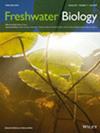淡水大型无脊椎动物驱动微观环境浮游细菌群落组成和活性
IF 2.8
2区 生物学
Q2 ECOLOGY
引用次数: 0
摘要
水生系统中的养分循环和有机物转化主要由微生物进行,但大型无脊椎动物对沉积物的混合进一步促进了这一过程。尽管已知大型无脊椎动物对沉积物的生物地球化学和微生物群落的影响,但对大型无脊椎动物及其微生物群对淡水系统水柱的影响研究不足。采用微观方法研究了淡水双壳类动物河蚌(Corbicula fluminea)和小龙虾原螯虾(Procambarus vioscai paynei)对周边水体微生物群落的短期影响。测定了参与有机碳(β-葡萄糖苷酶)、磷酸(磷酸酶)和碳氮(n -乙酰氨基葡萄糖酶)分解的微生物酶的活性,并利用Illumina 16S rRNA基因测序对水柱和其他系统组分中的细菌群落进行了表征。小龙虾和双壳类动物都显著改变了水体中细菌群落的结构和功能。小龙虾对微生物酶活性的刺激程度大于双壳类,而双壳类对水柱酶活性的刺激程度高于低密度时。大型无脊椎动物的外部微生物群并不是植被或水柱细菌群落的重要菌群来源,但大型无脊椎动物的存在与水柱中某些细菌类群(如Comamonadaceae和Chitinophagaceae)的丰度增加有关。这些结果表明,即使在短期内,大型无脊椎动物也可能通过影响细菌群落来影响淡水生态系统水柱中的生物地球化学过程。这项研究有助于更深入地了解大型无脊椎动物和环境中微生物群落之间的关系,特别是对水柱过程的影响,这是大型无脊椎动物效应中经常被忽视的一个组成部分。考虑淡水生态系统所有组成部分之间的相互作用对于了解其功能至关重要,特别是在面临不断升级的环境压力时。本文章由计算机程序翻译,如有差异,请以英文原文为准。
Freshwater Macroinvertebrates Drive Planktonic Bacterial Community Composition and Activity in Microcosms
- Nutrient cycling and organic matter transformations in aquatic systems are primarily performed by microorganisms but are further facilitated through the mixing of sediment by macroinvertebrates. Despite known impacts of macroinvertebrates on the biogeochemistry and microbial community of sediments, the impact of macroinvertebrates and their microbiome on the water column of freshwater systems has been understudied.
- A microcosm approach was used to study the short-term effects that freshwater bivalves, Corbicula fluminea, and crayfish, Procambarus vioscai paynei, have on the microbial community in the surrounding water column. The activity of microbial enzymes involved in the breakdown of organic carbon (β-glucosidase), phosphate (phosphatase), and carbon and nitrogen (N-acetylglucosaminidase) were assayed, and the bacterial community in the water column and other system components was characterised using Illumina 16S rRNA gene sequencing.
- Crayfish and bivalves both significantly altered the structure and function of the bacterial community in the water column. Crayfish stimulated microbial enzyme activity to a greater extent than bivalves, whereas bivalves at higher densities increased water column enzyme activity more than when they were at lower densities.
- The external microbiomes of macroinvertebrates were not a significant source of bacterial populations to the bacterial communities of vegetation or the water column, but macroinvertebrate presence was associated with an increased abundance of certain bacterial taxa in the water column, such as Comamonadaceae and Chitinophagaceae.
- These results demonstrate that, even in the short term, macroinvertebrates can impact biogeochemical processes in the water column of freshwater ecosystems, potentially by influencing the bacterial community.
- This study contributes to a deeper understanding of the relationships between macroinvertebrates and microbial communities in their environment, with specific implications for processes in the water column, a component that is frequently overlooked in terms of macroinvertebrate effects. Considering interactions between all components of freshwater ecosystems is crucial to understanding their functioning, especially in the face of escalating environmental pressures.
求助全文
通过发布文献求助,成功后即可免费获取论文全文。
去求助
来源期刊

Freshwater Biology
生物-海洋与淡水生物学
CiteScore
5.90
自引率
3.70%
发文量
162
审稿时长
2 months
期刊介绍:
Freshwater Biology publishes papers on all aspects of the ecology of inland waters, including rivers and lakes, ground waters, flood plains and other freshwater wetlands. We include studies of micro-organisms, algae, macrophytes, invertebrates, fish and other vertebrates, as well as those concerning whole systems and related physical and chemical aspects of the environment, provided that they have clear biological relevance.
Studies may focus at any level in the ecological hierarchy from physiological ecology and animal behaviour, through population dynamics and evolutionary genetics, to community interactions, biogeography and ecosystem functioning. They may also be at any scale: from microhabitat to landscape, and continental to global. Preference is given to research, whether meta-analytical, experimental, theoretical or descriptive, highlighting causal (ecological) mechanisms from which clearly stated hypotheses are derived. Manuscripts with an experimental or conceptual flavour are particularly welcome, as are those or which integrate laboratory and field work, and studies from less well researched areas of the world. Priority is given to submissions that are likely to interest a wide range of readers.
We encourage submission of papers well grounded in ecological theory that deal with issues related to the conservation and management of inland waters. Papers interpreting fundamental research in a way that makes clear its applied, strategic or socio-economic relevance are also welcome.
Review articles (FRESHWATER BIOLOGY REVIEWS) and discussion papers (OPINION) are also invited: these enable authors to publish high-quality material outside the constraints of standard research papers.
 求助内容:
求助内容: 应助结果提醒方式:
应助结果提醒方式:


